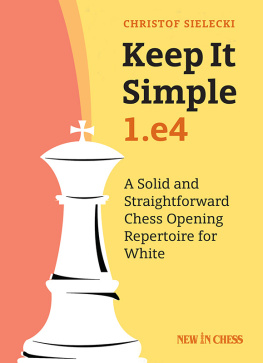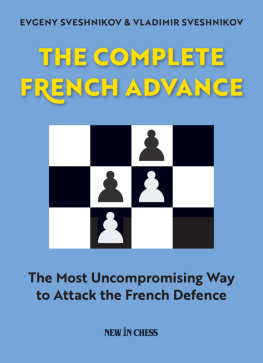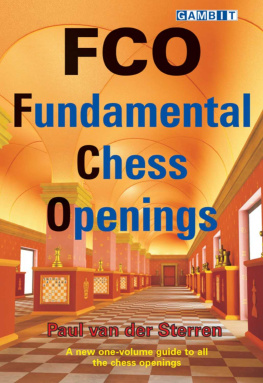
First published in 2011 by Gloucester Publishers plc (formerly Everyman Publishers plc), Northburgh House, 10 Northburgh Street, London EC1V 0AT
Copyright 2011 Simon Williams
The right of Simon Williams to be identified as the author of this work has been asserted in accordance with the Copyrights, Designs and Patents Act 1988.
All rights reserved. No part of this publication may be reproduced, stored in a retrieval system or transmitted in any form or by any means, electronic,
electrostatic, magnetic tape, photocopying, recording or otherwise, without prior permission of the publisher.
British Library Cataloguing-in-Publication Data
A catalogue record for this book is available from the British Library.
ISBN: 978 1 85744 720 0
Distributed in North America by The Globe Pequot Press, P.O Box 480,
246 Goose Lane, Guilford, CT 06437-0480.
All other sales enquiries should be directed to Everyman Chess, Northburgh House,
10 Northburgh Street, London EC1V 0AT
tel: 020 7253 7887 fax: 020 7490 3708
email: info@everymanchess.com; website: www.everymanchess.com
Everyman is the registered trade mark of Random House Inc. and is used in this work under licence from Random House Inc.
Everyman Chess Series
Chief advisor: Byron Jacobs
Commissioning editor: John Emms
Assistant editor: Richard Palliser
Typeset and edited by First Rank Publishing, Brighton.
Cover design by Horatio Monteverde.
Printed and bound in Great Britain by Clays, Bungay, Suffolk .
Contents
Bibliography
Books
Dangerous Weapons: The French , John Watson (Everyman Chess 2007)
The Flexible French , Viktor Moskalenko (New in Chess 2009)
Play Chess like the Pros , Danny Gormally (Everyman Chess 2010)
Play the French (3rd edition), John Watson (Everyman Chess 2003)
Electronic Resources
ChessPublishing.com
Killer French Defence (Parts 1 and 2), Simon Williams (Ginger GM DVD 2010)
Mega Database 2010 (ChessBase)
The Week in Chess
Introduction
One of the great attractions of chess is that the game spreads its wings to cover the whole social ladder. No matter where a person is from, what age they are, or even where they are going, chess can be shared as a tool for entertainment and knowledge. Children, adults, men, women, lawyers, politicians, prisoners, accountants, Napoleon, etc, can all enjoy a good game of chess.
When the battle commences the outside world is forgotten and the players can drift off into their own world of the imagination. The one thing that I find most intriguing about the game is the way in which a persons personality can come across in the way that they play. My own style of play is stereotyped as being extremely attacking and rather gung-ho. A classic opposite is that of the English Grandmaster Keith Arkell. Keith is known for his love of the endgame and the nibble. Indeed, Danny Gormally described Keith as the Grinder and myself as the Gambler in his entertaining book, Play Chess like the Pros .
To me this is what makes the game of chess so exciting. Two equally strong players can have two completely different ways of looking at the same position. Individual personality really does come through when youre playing the game.
Now you may be wondering what on earth has this to do with the French Defence? Well, let me try to explain. Throughout the history of chess, the French Defence has had the reputation of being a rather solid opening where White has most of the attacking opportunities. It has been considered to be a fairly safe and solid reply to 1 e4, with Black often relying on his solid pawn formation to push the advantage through in the middlegame or even the ending.
Wilhelm Steinitz once said of the opening: I have never in my life played the French Defence, which is the dullest of all openings!
This is where I beg to differ. I have always considered the French to be an exciting opening that offers Black very good counterattacking possibilities. Steinitz had obviously not looked at the opening in the same way that I have! Indeed, in the context of chess, I am not even sure if the word Defence is appropriate when muttering the word French! The title of this book rather gives away what we are going to be aiming for. I have tried to pick the most aggressive, exciting and sound variations that are playable for Black in the French Defence. I have personally played most of these variations mentioned and they have often led to some great encounters.
If you really want to get to grips with the French Defence then I would recommend that after studying this book you also take a look to see what the top grandmasters are playing in the French, such as Berg, Korchnoi, Lputian and Morozevich. This will help you obtain an even better understanding of the opening as a whole. You must also try to get into the habit of working out what typical middlegame plans you should be aiming to execute and even what type of endgame structures benefit Black and White. Saying that, this book is hardly geared towards reaching an endgame!
I often think that the most important thing when learning any opening is to understand the main concepts behind the moves that both sides play. Thus unlike certain books we wont be diving head first into the variations. Instead we will begin by considering various key concepts, aiming to understand the various plans and aims on offer to both sides.
The French from
Blacks Perspective
1. The ... c5 pawn break
You will find it very hard to play a game in the French Defence without playing this advance. The move ... c5 is often used as a lever by Black, a lever that aims to attack Whites pawn centre.
By the nature of the opening moves White normally gains a space advantage and without any pawn breaks Black would be left with a horribly passive position. This is just one reason why it is so important to chip away at Whites centre.

Here we have a typical French Advance pawn structure and in this position Black should play 3 ... c5! . This is such an important pawn break to remember! Without this break White would have a very solid grip over the centre.
In the French Black must do his best to keep attacking Whites centre.
Later on we will see that the Advance Variation of the French can often develop into a game of ping-pong. Black attacks the centre, White defends the centre, Black attacks the centre ...
2. The ... f6 pawn break
You will often find that one of the main assets that White has in the French is his pawn on e5. This pawn cramps Blacks position and gives White a basis to develop an attack from. Thus it is often a good idea to attack the bridgehead with the break ... f6.
J.Hector-E.Berg
Swedish League 2005

By playing the undermining 9 ... f6! Black was able to generate some action in the centre and on the kingside. It is worth noting that the break ... c5 was ruled out here due to White having pawns on b4 and d4, so Black really had to rely on the ... f6 break in order to avoid being suffocated. This was a great game and I recommend that you take your time going over it later on in Chapter Three.
3. Activating Blacks light-squared
bishop via d7 and e8
With the move 1 ... e6 Black voluntarily cages in his light-squared bishop. This minor piece can easily remain a bad one throughout the game. For this reason Black should always keep his eyes open for the chance to give it some life.
Next page




















